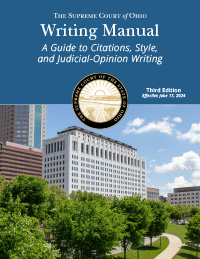Reading and Writing Legal Briefs and Opinions Is Getting Easier

The third edition of the Supreme Court of Ohio Writing Manual will become effective June 17, 2024.

The third edition of the Supreme Court of Ohio Writing Manual will become effective June 17, 2024.
The third edition of the Supreme Court of Ohio Writing Manual is now available and promises to improve the readability of legal documents.
The Writing Manual is the Ohio authority in legal practice for the structure, style, and format of opinions from all courts. It is also widely used as the standard for drafting briefs and pleadings filed with the courts.
More than a decade since the last edition was released, legal research is conducted, and briefs and opinions are read, primarily online rather than on paper. To address technological innovation, and to simplify and modernize legal writing, Chief Justice Sharon L. Kennedy established a committee to revise the Writing Manual in February 2023.
“For attorneys who file briefs it should save them time and expense,” said Chief Justice Kennedy. “Above all, I hope that by making opinions more readable, every citizen will read the opinions behind the decisions to better understand the work of the judiciary in Ohio. Our colleagues and I are grateful to Justice R. Patrick DeWine for chairing the committee and to Justice Melody J. Stewart for serving.”
In addition to the justices the committee was made up of staff who research and draft opinions; attorneys from the civil and criminal bar including prosecutors and defense counsel; legal writing instructors from Ohio law schools; and more. The practitioners were divided into subcommittees, each reviewing and updating one of the sections of the Writing Manual.
The Writing Manual is made up of three parts: the Manual of Citations, Style Guide, and Structure of a Judicial Opinion.
No More Parallel Citations
The biggest change presented in the new edition is the shortening of case citations. Case citations tell the reader where to find a judicial opinion. Historically, when the decision and opinions in a case were printed in two or more different legal reference books, the locations of each were cited in a brief. The idea was to make it easy to locate a case, regardless of which reference book the reader used. This is called “parallel citation.” Today, researchers work primarily online. Parallel citations are no longer necessary since online reference tools have the power to find a case without following the structure of a printed reference.
Ohio will no longer require case citations to cite print publications. An attorney need only cite the web location. Ohio has already been a leader in public domain citation. All cases decided after April 30, 2002, can be found on the SupremeCourt.ohio.gov website. Now, Ohio at the forefront of efforts to modernize citation format. In requiring that only its public domain “WebCite” be cited, Ohio joins Colorado and Illinois as one of three states that have adopted this important change to improve the readability of judicial opinions.
“I am proud that Ohio is now at the forefront in modernizing legal writing,” said Justice DeWine. “These changes will make legal writing more readable, legal opinions shorter, and save lawyers time.”
New guidance based on citation trends can also be found in the new edition. This includes guidelines for citing internet sources, including the use of “permalinks”. These are links that remain unchanged, unlike a link to a web page that can be broken or where the page content becomes unavailable.
Easy to Use
As an added tool, the Writing Manual now includes a “Citations at a Glance” handy reference tool. This was developed from a listing of the most common citation forms that attorneys at the Supreme Court use every day when drafting and editing opinions. And it is now available to all legal writers.
This edition provides new, different, and updated examples to illustrate how to build components of legal opinions. There is updated guidance for using acronyms, abbreviations, and parenthetical nicknames. And it is all easier to find within the Manual, with embedded links in the table of contents for navigating the electronic edition.
Future Lawyers
Before beginning its work, the manual revision committee surveyed legal writing instructors about how they train future lawyers and what their needs are. Most instructors teach The Blue Book uniform system of citation first, and many noted that the Blue Book and the Writing Manual gave different guidance. For example, the Blue Book advises using the section symbol (§), while previous editions of the Writing Manual advised that the word “section” be written out. Under the Blue Book, traditional ellipses (. . .) are used to indicate when words were left out, but the previous version of the Manual used asterisks for ellipses (* * *). Arbitrary differences like these have been removed.
When the subcommittees finished their work, recommendations were sent to the full committee for review. The final recommended changes went to the full Court for approval and the result is the Supreme Court of Ohio Writing Manual (Third Edition).
The second edition will remain available on the Court website until June 17, 2024, when the third edition goes into effect. The overlapping months give practitioners time to try it out and learn the differences between the two editions.
Questions or comments on the Writing Manual can be directed to the Supreme Court Office of the Reporter at REP@sc.ohio.gov or at 800.826.9010. Print copies of the Supreme Court of Ohio Writing Manual may be provided upon request.


